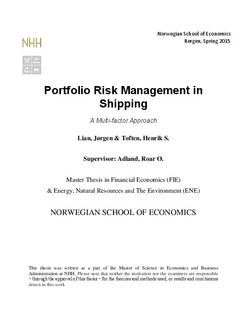| dc.description.abstract | This paper applies modern portfolio theory to manage portfolio risk for real shipping investments. The aim is to propose a multi-factor model for explaining vessel return variation. In doing so, we seek to improve extant research on shipping markets and clarify the underlying risk factors in the industry. To corroborate the necessity of a more comprehensive model, we include other well-established methods for comparison.
The study comprises the three main shipping segments, i.e. wet bulk, dry bulk and container. By including different segments, an investor can diversify segment-specific risks connected to the particular trade flows and seasonal demand patterns. Additionally, we include vessel size and age to enrich the investment universe. Different sized vessels are exposed to different trades due to characteristics of cargo and physical limitations, e.g. stowage factor and canal dimensions. Larger vessels are therefore exposed to more operational risk in terms of flexibility than smaller vessels. The age factor also represents a differing risk profile of the investment, as newer vessels with favorable cost structures are theoretically less risky albeit more expensive.
We find clear differences in risk-return characteristics regarding all three aspects between the various vessels. This indicates great diversification potential. We show the superiority of the multi-factor model compared to the naïve and single-index optimization frameworks. Our model highlights five main risk factors and vastly improves the explanatory power of return variation.
From a statistical point of view, a diversified portfolio outperforms segment-specific portfolios within dry bulk and container vessels. This is not the case for wet bulk, following the strong performance of recent years. Economically, we find recent trends in shipping to accommodate diversification following a decomposition of the value chain, e.g. Ship Finance International Ltd. This enables diversifying across all segments, in turn reducing cash-flow volatility and possibly adding value for shareholders. | nb_NO |
